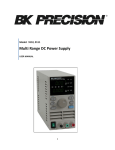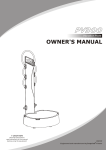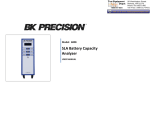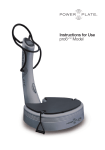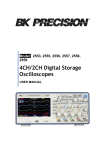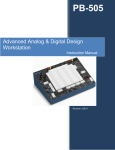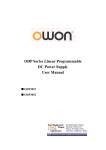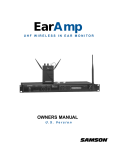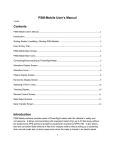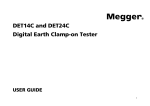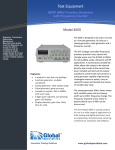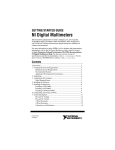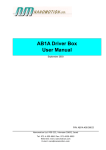Download User Manual Dual Output DC Power Supply
Transcript
99 Washington Street Melrose, MA 02176 Phone 781-665-1400 Toll Free 1-800-517-8431 Visit us at www.TestEquipmentDepot.com Dual Output DC Power Supply 1415 User Manual Safety Summary A WARNING statement calls attention to an operating procedure, practice, or condition, which, if not followed correctly, could result in injury or death to personnel. A CAUTION statement calls attention to an operating procedure, practice, or condition, which, if not followed correctly, could result in damage to or destruction of parts or the entire product. The following safety precautions apply to both operating and maintenance personnel and must be followed during all phases of operation, service, and repair of this instrument. WARNING Before applying power to this instrument: • Read and understand the safety and operational information in this manual. • Apply all the listed safety precautions. • Verify that the voltage selector at the line power cord input is set to the correct line voltage. Operating the instrument at an incorrect line voltage will void the warranty. • Make all connections to the instrument before applying power. • Do not operate the instrument in ways not specified by this manual or by Global Specialties Electrical Power This instrument is intended to be powered from a CATEGORY II mains power environment. The mains power should be 120 V RMS or 240 V RMS. Use only the power cord supplied with the instrument and ensure it is appropriate for your country of use. Ground the Instrument WARNING To minimize shock hazard, the instrument chassis and cabinet must be connected to an electrical safety ground. This instrument is grounded through the ground conductor of the supplied, threeconductor AC line power cable. The power cable must be plugged into an approved three-conductor electrical outlet. The power jack and mating plug of the power cable meet IEC safety standards. WARNING Do not alter or defeat the ground connection. Without the safety ground connection, all accessible conductive parts (including control knobs) may provide an electric shock. Failure to use a properlygrounded approved outlet and the recommended three-conductor AC line power cable may result in injury or death. WARNING Unless otherwise stated, a ground connection on the instrument's front or rear panel is for a reference of potential only and is not to be used as a safety ground. Do not operate in an explosive or flammable atmosphere WARNING Do not operate the instrument in the presence of flammable gases or vapors, fumes, or finely divided particulates. Use only in office-type indoor setting WARNING The instrument is designed to be used in office-type indoor environments. Do not operate the instrument: • In the presence of noxious, corrosive, or flammable fumes, gases, vapors, chemicals, or finely-divided particulates. • In relative humidity conditions outside the instrument's specifications. • In environments where there is a danger of any liquid being spilled on the instrument. • In air temperatures exceeding the specified operating temperatures. • In atmospheric pressures outside the specified altitude limits or where the surrounding gas is not air. • In environments with restricted cooling air flow, even if the air temperatures are within specifications. • In direct sunlight. CAUTION This instrument is intended to be used in an indoor pollution degree 2 environment. The operating temperature range is 0 °C to 40 °C and the operating humidity range is up to 80% relative humidity with no condensation allowed. Measurements made by this instrument may be outside specifications if the instrument is used in non-officetype environments. Such environments may include rapid temperature or humidity changes, sunlight, vibration and/or mechanical shocks, acoustic noise, electrical noise, strong electric fields, or strong magnetic fields. Do not operate instrument if damaged If the instrument is damaged, appears to be damaged, or if any liquid, chemical, or other material gets on or inside the instrument, remove the instrument's power cord, remove the instrument from service, label it as not to be operated, and return the instrument to Global Specialties for repair. Notify Global Specialties of the nature of any contamination of the instrument. Clean the instrument only as instructed Do not clean the instrument, its switches, or its terminals with contact cleaners, abrasives, lubricants, solvents, acids/bases, or other such chemicals. Clean the instrument only with a clean dry lint-free cloth or as instructed in this manual. Not for critical applications WARNING This instrument is not authorized for use in contact with the human body or for use as a component in a life-support device or system. Do not touch live circuits WARNING Instrument covers must not be removed by operating personnel. Component replacement and internal adjustments must be made by qualified service-trained maintenance personnel who are aware of the hazards involved when the instrument's covers and shields are removed. Under certain conditions, even with the power cord removed, dangerous voltages may exist when the covers are removed. To avoid injuries, always disconnect the power cord from the instrument, disconnect all other connections (for example, test leads, computer interface cables, etc.), discharge all circuits, and verify there are no hazardous voltages present on any conductors by measurements with a properly-operating voltage-sensing device before touching any internal parts. Verify the voltage-sensing device is working properly before and after making the measurements by testing with known-operating voltage sources and test for both DC and AC voltages. Do not attempt any service or adjustment unless another person capable of rendering first aid and resuscitation is present. Do not insert any object into an instrument's ventilation openings or other openings. WARNING Hazardous voltages may be present in unexpected locations in circuitry being tested when a fault condition in the circuit exists. Fuse replacement WARNING Fuse replacement must be done by qualified service-trained maintenance personnel who are aware of the instrument's fuse requirements and safe replacement procedures. Disconnect the instrument from the power line before replacing fuses. Replace fuses only with new fuses of the fuse types, voltage ratings, and current ratings specified in this manual or on the back of the instrument. Failure to do so may damage the instrument, lead to a safety hazard, or cause a fire. Failure to use the specified fuses will void the warranty. Servicing CAUTION Do not substitute parts that are not approved by Global Specialties or modify this instrument. Return the instrument to Global Specialties for service and repair to ensure that safety and performance features are maintained. Cooling fans CAUTION This instrument contains one or more cooling fans. For continued safe operation of the instrument, the air inlet and exhaust openings for these fans must not be blocked nor must accumulated dust or other debris be allowed to reduce air flow. Maintain at least 25 mm clearance around the sides of the instrument that contain air inlet and exhaust ports. If mounted in a rack, position power devices in the rack above the instrument to minimize instrument heating while rack mounted. Do not continue to operate the instrument if you cannot verify the fan is operating (note some fans may have intermittent duty cycles). Do not insert any object into the fan's inlet or outlet. Use correctly sized wires WARNING To connect a load to the power supply, use a wire diameter large enough to handle the maximum continuous output short-circuit current of the power supply without the wire overheating. For continued safe use of the instrument • • • • • Do not place heavy objects on the instrument. Do not obstruct cooling air flow to the instrument. Do not place a hot soldering iron on the instrument. Do not pull the instrument with the power cord, connected probe, or connected test lead. Do not move the instrument when a probe is connected. Compliance Statements Disposal of Old Electrical & Electronic Equipment (Applicable in the European Union and other European countries with separate collection systems). This product is subject to Directive 2012/19/EU of the European Parliament and the Council of the European Union on waste electrical and electronic equipment (WEEE), and in jurisdictions adopting that Directive, is marked as being put on the market after August 13, 2005, and should not be disposed of as unsorted municipal waste. Please utilize your local WEEE collection facilities in the disposition of this product and otherwise observe all applicable requirements. The 1415 is CE compliant. Table of Contents 1 General Information .................................................................. 8 1.1 1.2 1.3 1.4 1.5 1.6 Product Overview Features Constant Voltage (CV) /Constant Current (CC) Mode Package Contents Front Panel Overview Rear Panel 8 8 8 9 10 11 2 Getting Started ......................................................................... 12 2.1 Input Power and Fuse Requirements 12 2.2 Fuse Requirements 12 2.3 Line Voltage Selection 13 2.3.1 Check and/or Change Fuse ....................................................... 13 2.3.2 Check and/or Change Line Voltage Switch ............................... 13 2.4 Ventilation 14 3 Operating the Power Supply .................................................. 14 3.1 Setting the Variable Output Voltage & Current 14 3.2 System Configuration 15 3.2.3 Multiple Units in Series .............................................................. 15 3.2.4 Multiple Units in Parallel ............................................................ 16 3.3 Fixed 5V/3A Output 16 4 Specifications .......................................................................... 17 5 Maintenance ............................................................................. 18 5.1 Preventative Steps 5.2 When the Unit is Not Turning On 5.3 Fuse Replacement 18 18 18 6 Service and Warranty Information ......................................... 19 6.1 Limited One-Year Warranty 6.2 Calibration and Repair 19 19 1 General Information 1.1 Product Overview Global Specialties Model 1415 Dual Output DC Power Supply provides one variable output (0 – 30 V / 0 – 3 A) and one fixed output (5 V / 3 A). The variable output features both constant current & constant voltage modes with automatic crossover between the two. Each mode has its own LED indicator. Connect multiple units in series or in parallel for greater voltage or current output. 1.2 Features • • • • • • • • • • One variable output: 0-30 V / 0-3 A One fixed output: 5 V / 3 A Separate 3-digit displays for voltage and current on the variable output Individual control of voltage and current for the variable output CV (constant voltage) / CC (constant current) mode operation LED indication for CV / CC mode Overload indication LED for the fixed output Operate multiple units in series or in parallel for greater output Power On/Off switch on front panel Input voltage selection on rear side (120/240 VAC) 1.3 Constant Voltage (CV) /Constant Current (CC) Mode The working characteristic of this power supply is called a constant voltage/constant current automatic crossover type. This permits continuous transition from constant current to constant voltage modes in response to the load change. The intersection of constant voltage and constant current modes is called the crossover point. Figure 1 shows the relationship between this crossover point and the load. For example, if the load is such that the power supply is operating in the constant voltage mode, a regulated output voltage is provided. The output voltage remains constant as the load increases, up until the point where the preset current limit is reached. At that point, the output current becomes constant and the output voltage drops in proportion to further increases in load. Figure 1: CC, CV Characteristics The crossover point is indicated by the front panel LED indicators. The crossover point is reached when the CV indicator goes off and the CC indicator comes on. Similarly, crossover from the constant current to the constant voltage mode automatically occurs from a decrease in load. 1.4 Package Contents Please inspect the instrument mechanically and electrically upon receiving it. Unpack all items from the shipping carton, and check for any obvious signs of physical damage that may have occurred during transportation. Report any damage to the shipping agent immediately. Save the original packing carton for possible future reshipment. The 1415 power supply is shipped with the following contents: • • • • 1415 Power Supply AC Power Cord User Manual Banana Plug to Alligator Clip Lead Wires (Black & Red) 1.5 Front Panel Overview Figure 2: Front Panel 1. 2. 3. 4. 5. 6. 7. 8. 9. 10. 11. 12. 13. Power switch Negative output terminal of the fixed 5V/3A output (black) Positive output terminal of the fixed 5V/3A output (red) Overload indicator LED for the fixed 5V/3A output Negative output terminal of the variable output Ground terminal of the variable output Positive output terminal of the variable output CC mode LED to indicate constant current CV mode LED to indicate constant voltage Variable output voltage adjustment knob Variable output current adjustment knob Variable voltage indicator display (3-digit green 0.52" LED) Variable current indicator display (3-digit red 0.52" LED) Figure 3: Front Panel Diagram 1.6 Rear Panel A. B. C. D. Heat sink: Heat dissipation for power transistor Ventilation Fan: 8" 24 VDC fan Power input socket Fuse holder and input voltage selector: The selected input voltage is set to the voltage shown near the ▽ mark which points to “E.” E. The input power voltage indicator: The ▽ mark points to the set input line voltage Figure 4: Rear Panel 2 Getting Started 2.1 Input Power and Fuse Requirements The supply has a selectable AC input that accepts line voltage input within: • • Voltage: 115 V or 230 V (±10%) Frequency: 47 Hz – 63 Hz Before connecting to an AC outlet or external power source, be sure that the power switch is in the OFF position and verify that the AC power cord, including the extension line, is compatible with the rated voltage/current and that there is sufficient circuit capacity for the power supply. Once verified, connect the cable firmly. WARNING The included AC power cord is safety certified for this instrument operating in rated range. To change a cable or add an extension cable, be sure that it can meet the required power ratings for this instrument. Any misuse with wrong or unsafe cables will void the warranty. WARNING The power cord provides a chassis ground through a third conductor. Verify that your power outlet is of the three-conductor type with the correct pin connected to earth ground. 2.2 Fuse Requirements An AC input fuse is necessary when powering the instrument. The below table shows the fuse required for all models operating with either 120 VAC or 240 VAC input. Selector Line Voltage Fuse 120 V 240 V 114 – 126 V, 50/60 Hz 228 – 252 V, 50/60 Hz 3.0 A, 250 V 1.5 A, 250 V 2.3 Line Voltage Selection The power supplies can be selected to operate with 110 V input or 220 V input. To ensure that your instrument is properly configured to operate at the desired AC line voltage, please follow the steps below. WARNING For safety, no power should be applied to the instrument while changing line voltage operation. Disconnect all cables connected to the instrument before proceeding. 2.3.1 Check and/or Change Fuse • • • Locate the fuse box next to the AC input connector in the rear panel (see Figure 4). With a small flat blade screwdriver, insert into the fuse box slit to pull and slide out the fuse box as indicated below. Check and replace fuse (if necessary) for the desired line voltage operation (see section 2.2). 2.3.2 Check and/or Change Line Voltage Switch The input power voltage indicator is a black arrow ▽ on the rear panel near the AC input connector. See Figure 4, “E”. The fuse holder (Figure 4, “D”) has a both a smaller white arrow ▽ (120 V) and a smaller black arrow (240 V) on it. The fuse holder should be rotated so that the fuse holder arrow of the appropriate voltage is pointing to the larger black input power voltage indicator arrow. See Figures 5 & 6 below. Figure 5: 120 V Setup Figure 6: 240 V Setup CAUTION Do not connect power to the instrument until the line voltage selection is setup correctly. Applying an incorrect line voltage or configuring the line voltage selection improperly may damage the instrument and void all warranty. 2.4 Ventilation CAUTION Also make sure the ventilation holes are not blocked. Ensure the ventilation fan is working well (it should turn on at power-on). Do not load the output if fan is not working otherwise it may cause overheating. 3 Operating the Power Supply 3.1 Setting the Variable Output Voltage & Current 1. 2. 3. 4. 5. 6. 7. As per load requirement, calculate the voltage and maximum current limit to be set on output. Note: V=IR Disconnect the load from output terminals. For current limit adjustment, turn the current adjustment knob counter-clockwise to get minimum current output. Short the circuit between the positive and negative variable output terminals by the accessory leads. Vary the current adjustment knob clockwise until the current displays the required current limit. The CC LED will be lit while adjusting the current limit. Remove the accessory lead after current limit adjustment. The voltage will be displayed and the CV LED will be lit. Vary the voltage adjustment knob to get the desired output voltage on the display. The power supply can automatically operate between constant voltage and constant current modes, responding quickly to load changes. When the CC LED (red) lights up, the CV LED (green) will be off and the voltage display will be inactive. 3.2 System Configuration Model 1415 can be operated alone or connected to two or more other units in series to obtain a higher voltage rating (maximum 240 V), or in parallel to obtain a higher current rating (maximum 24 A). CAUTION: The GND (green) output terminal should not be used during series or parallel configuration. 3.2.3 Multiple Units in Series 1. 2. 3. 4. Set the output current of all connected units equal to or higher than the desired current and at least one unit must be set to the desired current. Connect the negative output terminal of unit 1 to the positive output terminal of unit 2 (or the next unit). Repeat for units 2 and 3, and so forth, if needed. Connect the load between the positive terminal of unit 1 and the negative terminal of the last unit. The total output voltage will be the sum of the output voltage of each of the units. The output current will be the equal to the lowest output current set on these connected units. CAUTION: The total output voltage must not exceed 240 V. Figure 7: Series Connection 3.2.4 Multiple Units in Parallel 1. 2. 3. 4. Adjust all units to the same output voltage. Make the parallel connection of the positive and the negative terminals of units 1 and 2. Repeat for units 2 and 3, and so forth, if needed. Connect the load between the positive and negative terminals of the last unit. The total output current will be the sum of the output current of each the units. The output voltage will be the voltage set above. Figure 8: Parallel Connection CAUTION: The total output current must not exceed 24 A. 3.3 Fixed 5V/3A Output This is the standard 5V/3A power output provided for supplying the power to TTL logic circuits. When the load attempts to draw more than 3 amps from the output, the OVERLOAD indicator will light and the power supply will fold back, reducing both the output voltage and current to well below the normal operating limits. 4 Specifications All specifications apply to the unit after a temperature stabilization time of 15 minutes over an ambient temperature range of 25 °C ± 5 °C. 1415 Dual Output DC Power Supply Output Parameters Max Output Power Number of Outputs Range Load Regulation CC Mode CV Mode Fixed 5 V Output Line Regulation CC Mode CV Mode Fixed 5 V Output Ripple & Noise CC Mode CV Mode Fixed 5 V Output Display Accuracy Voltage & Current Fixed 5 V Output General AC Input Operating Temperature Operating Humidity Dimensions (W x H x D) Weight Warranty Included Accessories 105 W 2 independent & electrically isolated outputs Variable: 0-30 VDC / 0-3 A Fixed: 5 V / 3 A <15 mA ±0.05% + 32 mV <70 mV ±0.05% + 2 mA ±0.05% + 2 mV <5 mV <2.5 mArms <0.4 mVrms <1.5 mVrms 0.1% + 2 digits ± 0.25 V VAC 115/230 ±10%, 50/60 Hz 50 ºF to 104 ºF (10 ºC to 40 ºC) 90% R.H. 9 x 6.7 x 12.2 in (230 x 170 x 310 mm) 13.3 lbs (6.0 kg) One-year warranty Power cord, user manual, one pair of test leads 5 Maintenance 5.1 Preventative Steps Please follow these preventive steps to ensure the proper operation of your instrument. • • • • • • • • Never place heavy objects on the instrument. Never place a hot soldering iron on or near the instrument. Never insert wires, pins, or other metal objects into ventilation fan. Never move or pull the instrument with power cord or output lead. More importantly, never move the instrument when the power cord or output lead is connected. Do not obstruct the ventilation holes in the rear panel as this will increase the internal temperature. Do not operate the instrument with the cover removed unless you are a qualified service technician. Clean and recalibrate the instrument on a regular basis to keep the instrument looking nice and working well. Remove any dirt, dust, and grime whenever they become noticeable on the outside cover using a soft cloth moistened with a mild cleaning solution. 5.2 When the Unit is Not Turning On Check if the power ON/OFF switch is turned ON. Check for blown fuse. If not, then check the power cord. Please make sure that the power cord is properly connected to the unit. Please also check the main switch and ensure that the AC supply at your site is the same as the one mentioned at the rear chassis of the unit. 5.3 Fuse Replacement If the fuse blows, the LED will not light and the instrument will not operate. Replace only with the correct value fuse. See sections 2.2 and 2.3. 6 Service and Warranty Information 6.1 Limited One-Year Warranty Cal Test Electronics warrants this product to be free from defective material or workmanship for a period of 1 year from the date of original purchase. Under this warranty, Cal Test Electronics is limited to repairing the defective device when returned to the factory, shipping charges prepaid, within the warranty period. Units returned to Cal Test Electronics that have been subject to abuse, misuse, damage or accident, or have been connected, installed or adjusted contrary to the instructions furnished by Cal Test Electronics, or that have been repaired by unauthorized persons, will not be covered by this warranty. Cal Test Electronics reserves the right to discontinue models, change specifications, price, or design of this device at any time without notice and without incurring any obligation whatsoever. The purchaser agrees to assume all liabilities for any damages and/or bodily injury which may result from the use or misuse of this device by the purchaser, his employees, or agents. This warranty is in lieu of all other representations or warranties expressed or implied and no agent or representative of Cal Test Electronics is authorized to assume any other obligation in connection with the sale and purchase of this device. 6.2 Calibration and Repair If you have a need for any calibration or repair services, please visit us on the web at: globalspecialties.com. See the “Service” tab. Or contact us via the “Contact” tab. Test Equipment Depot - 800.517.8431 - 99 Washington Street Melrose, MA 02176 TestEquipmentDepot.com





















